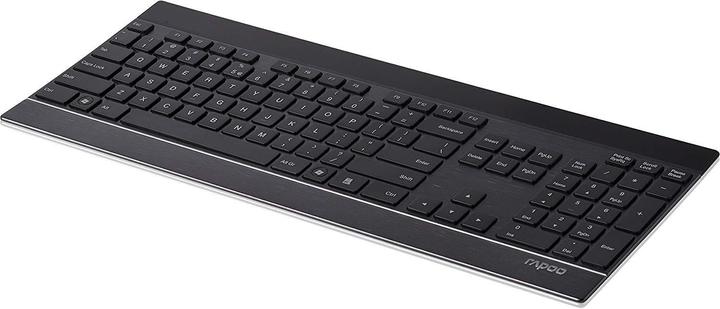

The Keyboard 4 Ultimate - My loud dream
Black keys and a lot of noise are the main characteristics of the keyboard, which is simply called The Keyboard. It also weighs a lot. Despite all these strange attributes, Das Keyboard is the best keyboard I've ever had the pleasure of working with.
Black. This is the main feature of Das Keyboard. The keyboard is one of the strangest keyboards on the Internet. The reason? It looks like this:

This isn't a production sketch or anything. The Texan manufacturer Metadot launched the first keyboard without labelling on the market in 2005. The internet, which was still young at the time, laughed. Hardcore coders, however, swore by the device and the first Das Keyboard was followed by even more technologically sophisticated versions up to the current version, the Das Keyboard 4 Ultimate.

My main problem was that I found the idea of the unlabelled keyboard fun, but not really the price. Nor could any of the sales arguments completely convince me that Das Keyboard is the device for me. Because it could be a total flop and if that's the case, then I've spent a lot of money on something that I just find funny but can't really use.
Therefore: a test device is a must.
The journalist and his tool
When I unpack the Das Keyboard 4 Ultimate, I notice that it is extremely heavy. Well, up to now I've been writing with a Logitech K120 at work. At home, I have a Rapoo Wireless Ultra-Slim lying around for reasons of simplicity.
The K120 is a keyboard that's lying around on every office desk. It doesn't do anything wrong, you can type away on it and it can take a beating. The Rapoo was a purchase out of necessity. Its predecessor broke one evening just before closing time and important keys such as the space bar and, strangely enough, the letter T no longer worked. So I went to the nearest electronics retailer and bought a keyboard. I was lucky with the Rapoo, because I really liked the thing, which is why I haven't replaced it to this day.
But I'm tricky. I realised on my first day at my new job that the K120 had no future with me. I don't know about you, dear reader, but I value good work material. As a journalist, that means writing materials such as my trusty everyday pen, the Caran d'Ache 828 Frosty in anthracite.
The situation is similar with keyboards. I want a keyboard that is easy to use. So it shouldn't have too low a pressure point, because otherwise I'll accidentally write a letter line by line during a pause for thought. Wireless or wired is more or less irrelevant to me, as long as I don't have to replace or recharge the batteries every two days. Media keys? Gladly, but not necessarily. Price: As much as necessary, as little as possible. The keyboard is definitely above my budget, and there's a high risk that I'll find it totally bonkers.
These are the kind of thoughts I have as a keyboard tester while I'm wiring, because there's not much else to think about under an office desk during working hours. Well, at best I was thinking about review criteria and overlooked the fact that the USB cable of Das Keyboard - by the way, I can't get used to the grammatical nightmare caused by the article in the product name - is pleasantly long. Longer than I have experienced with many other keyboards. This opens up a lot of freedom when positioning the computer. Nice. One problem less.
A hail of keystrokes
The moment has arrived. The first strokes. I'm still cautious, because somehow I'm still not entirely comfortable with the unlabelled keyboard. How am I supposed to know which letter is where? And I'm sure I'm making a million typos a minute. What use is a keyboard on which I can type faster, according to the manufacturer's advertising, but make more typing errors? The idea of Das Keyboard - grammar be damned - seems totally daft to me. Stupidest idea ever. What have I got myself into?

I open my text editor, Brackets, as I always do. I press the Windows key on my keyboard and start typing the word brackets until the entry is the only one shown by the search and press Enter. I've done this process thousands of times, which actually makes me laugh looking back.
My first attempts at typing take place in Brackets. That works after all! Actually, it works very well. My fingers fly over the keyboard, my error rate is low. I am happy. Not only because I can still type at my own pace, but also because I really like the mechanics of the key switches - the components that determine the pressure point of the keyboard. I can easily pause for a moment and leave my fingers on the keyboard without having to sssssss a line straight away. It's always S for me, I don't know why. My left ring finger seems to have a quirk somehow.
After five minutes of writing, it's clear: I'm extremely good at using the keyboard. Because, let's be honest: you and I actually know where the keys are on our keyboards. I typed my name on a keyboard for the first time about 25 years ago, officially learnt the ten-finger system at school in 1997 and have never had a job where I didn't type on a keyboard a lot. I don't need the labelling. Neither does my mum, because even if she never types as fast as I do, she knows where the keys are. Keyboards have eaten their way into our collective memory. Labelling is nice, but it's superfluous.
It's thundering in the editorial team
The longer I work with Das Keyboard - wah, grammar - the faster I get. It turns out that I'm still looking at the keyboard, despite being a very steady typist. The result: a second or so delay. This has never really bothered me, but I'm glad I don't have it anymore. My already fast hacking on the keyboard turns into a veritable machine-gun barrage of keystrokes. I still make typos, but not really any more than before. Or less. That's totally fine with me.
"Hey, old man...", I hear my editorial colleague Phil say. He laughs and asks if I'm OK making such a big noise. The page-long drum roll of keyboard strokes hasn't escaped his notice and intern Ramon just shakes his head with a grin.
I immediately realise that The Keyboard - hey, grammar is working for once - has no future in the office. I didn't mind the "Tak Tak Tak" because I organised it. On the contrary, I enjoy it. But I also realise that The Keyboard is louder than any other keyboard I've ever used in an office environment.

But I don't want to give the keyboard away. It's just too good. It's by far the best keyboard I've ever typed on. It feels like it was made for me. The Cherry MX Brown switches, optimised for typing according to the manufacturer, have the perfect resistance and the texture of the keys feels exactly as it should. The volume control at the top right is not only pleasantly large so that I can turn down the volume of my music at lightning speed, but is also nicely integrated into the design.
The keyboard has replaced my Rapoo. It cost me a bundle, but I don't regret a single cents. Not a single one.
In short: the keyboard is the keyboard you want. You just don't know it yet. But please, overcome your caution and invest in the keyboard. Even if we don't have it in stock right now, order it. It will be available soon. Because it's worth it. I promise.
The search continues for my office. I'm looking for a mechanical keyboard that is quiet and has interchangeable keys. So if you know of one, please leave me your recommendation in a comment.
You might also be interested in this
Journalist. Author. Hacker. A storyteller searching for boundaries, secrets and taboos – putting the world to paper. Not because I can but because I can’t not.


